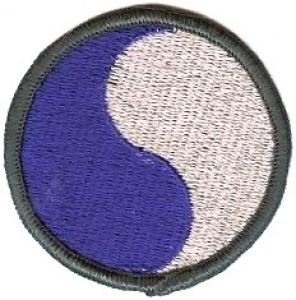29 Infantry Division Patch. US Army
Mainīt informāciju
Description
Upon a disc with a 1/8 inch (.32 cm) green border 2 1/2 inches (6.35 cm) in diameter overall, a Taeguk, the curves being circles of half the radius of the disc, with the heraldic dexter half being blue and the sinister half gray.
Symbolism
In 1919, when shoulder sleeve insignia were first authorized, the division was composed of two masses of men, one from the North and the other from the South. Therefore, the North is represented by the blue and the South by the gray.
Background
The shoulder sleeve insignia was originally approved for the 29th Division by telegram on 21 October 1918. It was reaffirmed by letter dated 17 June 1922. The insignia was amended to change the description on 4 May 1925. The insignia was redesignated for the 29th Infantry Division and amended to update the description and include a symbolism on 16 may 1985. (TIOH Dwg. No. A-1-94)
Upon a disc with a 1/8 inch (.32 cm) green border 2 1/2 inches (6.35 cm) in diameter overall, a Taeguk, the curves being circles of half the radius of the disc, with the heraldic dexter half being blue and the sinister half gray.
Symbolism
In 1919, when shoulder sleeve insignia were first authorized, the division was composed of two masses of men, one from the North and the other from the South. Therefore, the North is represented by the blue and the South by the gray.
Background
The shoulder sleeve insignia was originally approved for the 29th Division by telegram on 21 October 1918. It was reaffirmed by letter dated 17 June 1922. The insignia was amended to change the description on 4 May 1925. The insignia was redesignated for the 29th Infantry Division and amended to update the description and include a symbolism on 16 may 1985. (TIOH Dwg. No. A-1-94)
Citas kategorijas: Kājnieki
 90 Infantry Division Patch. US Army
90 Infantry Division Patch. US Army
 10 Mountain Division Patch. US Army
10 Mountain Division Patch. US Army
 103 Infantry Division Patch. US Army
103 Infantry Division Patch. US Army
 301 Maneuver Enhancement Brigade Patch. US Army
301 Maneuver Enhancement Brigade Patch. US Army
 27 Infantry Brigade Combat Team Patch. US Army
27 Infantry Brigade Combat Team Patch. US Army








